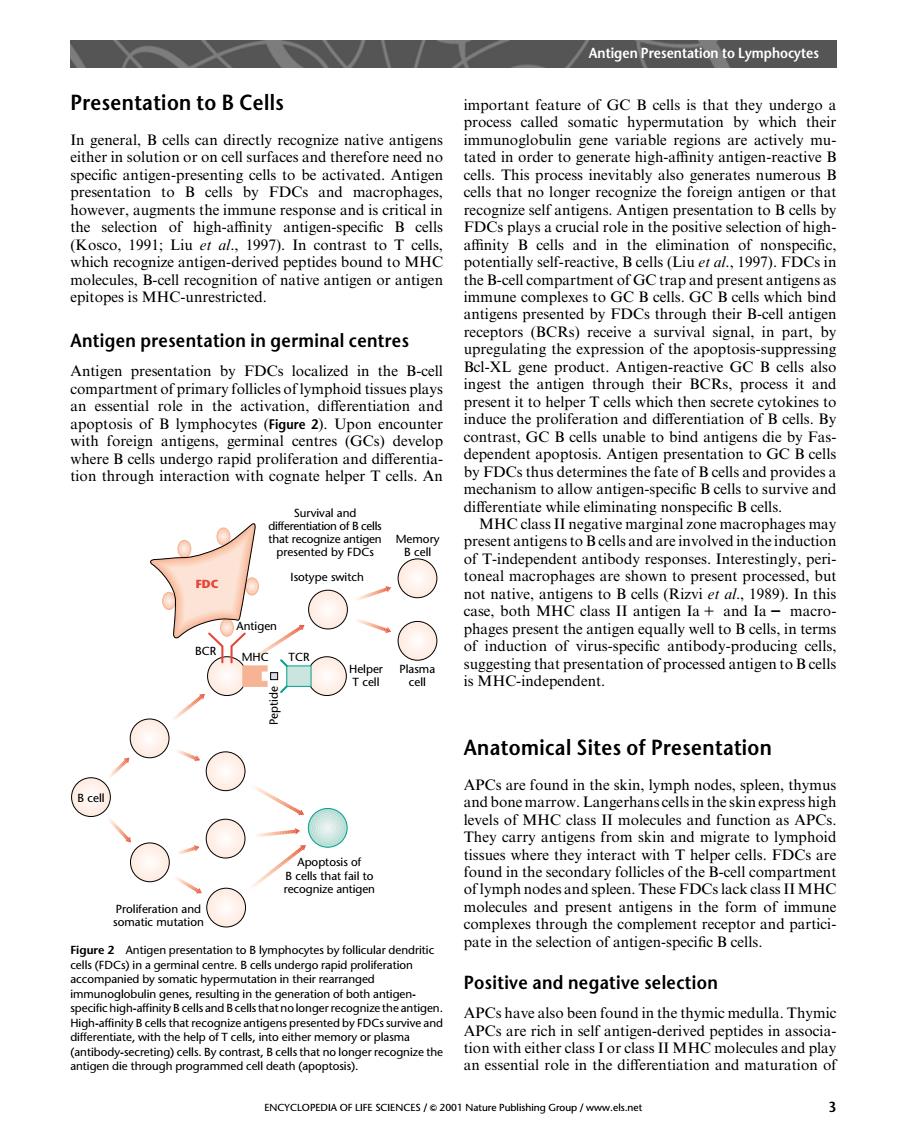正在加载图片...

Antigen Presentation to Lymphocytes Presentation to B Cells important feature of gc b cells is that they undergo a process called somatic hypermutation by which their immunoglobulin gene varia Igen-reacuve presentation to B cells by FDCs and macrophages cells that no longer recognize the foreign antigen or that however,augments the immune response and is critical in antigen-specific B Dpnration to s plays a nity sef-n molecules,B-cell recognition of native antigen or antigen the B-cell compartment of GCtrap and present antigens as epitopes is MHC-unrestricted. immune complexes to GC B cells.GC B cells which bind d by FDCs through their B-cellatig Antigen presentation in germinal centres Antigen pre product.Antigen-reactiveGCBc ingest the antigen through their BCRs.process it and an essential role in the activation.differentiation and develop dependent apoptosis.Antigen presentation to GC B cells by FDCs thus determines the fate of B cells and provides 1L0 tigen-specific B cel urvive and esented by F sent antigens to B cells and are involved in the induction of Tindependent antibody responses.Interestingly.per Isotype switch one nacrophages are sh res). )In th n la t and la BCR KwmCdPemntaionorprocesodanientoBce Anatomical Sites of Presentation (5.co APCs are found in the skin.lymph nodes,spleen.thymus and bone marrow.Langerhanscells in the skinexpress high ith Tha igrat mpartm e ecognize antiger oflymph nodes and spleen.These FDCs lack class II MH nt antigens in the form o immun tein the Figure 2 Antige n presentation to B lymphocytes by follicular dendritic pat (FDCs) centre.B onnthepdproieratior Positive and negative selection b-affin igh-amn or uvive and recognize the an essential role in the differentiation and maturation of ENCYCLOPEDIA OF LIFE SCIENCES/2001 Na ublishing Group/www.els.netPresentation to B Cells In general, B cells can directly recognize native antigens either in solution or on cell surfaces and therefore need no specific antigen-presenting cells to be activated. Antigen presentation to B cells by FDCs and macrophages, however, augments the immune response and is critical in the selection of high-affinity antigen-specific B cells (Kosco, 1991; Liu et al., 1997). In contrast to T cells, which recognize antigen-derived peptides bound to MHC molecules, B-cell recognition of native antigen or antigen epitopes is MHC-unrestricted. Antigen presentation in germinal centres Antigen presentation by FDCs localized in the B-cell compartment of primary follicles of lymphoid tissues plays an essential role in the activation, differentiation and apoptosis of B lymphocytes (Figure 2). Upon encounter with foreign antigens, germinal centres (GCs) develop where B cells undergo rapid proliferation and differentiation through interaction with cognate helper T cells. An important feature of GC B cells is that they undergo a process called somatic hypermutation by which their immunoglobulin gene variable regions are actively mutated in order to generate high-affinity antigen-reactive B cells. This process inevitably also generates numerous B cells that no longer recognize the foreign antigen or that recognize self antigens. Antigen presentation to B cells by FDCs plays a crucial role in the positive selection of highaffinity B cells and in the elimination of nonspecific, potentially self-reactive, B cells (Liu et al., 1997). FDCs in the B-cell compartment of GC trap and present antigens as immune complexes to GC B cells. GC B cells which bind antigens presented by FDCs through their B-cell antigen receptors (BCRs) receive a survival signal, in part, by upregulating the expression of the apoptosis-suppressing Bcl-XL gene product. Antigen-reactive GC B cells also ingest the antigen through their BCRs, process it and present it to helper T cells which then secrete cytokines to induce the proliferation and differentiation of B cells. By contrast, GC B cells unable to bind antigens die by Fasdependent apoptosis. Antigen presentation to GC B cells by FDCs thus determines the fate of B cells and provides a mechanism to allow antigen-specific B cells to survive and differentiate while eliminating nonspecific B cells. MHC class II negative marginal zone macrophages may present antigens to B cells and are involved in the induction of T-independent antibody responses. Interestingly, peritoneal macrophages are shown to present processed, but not native, antigens to B cells (Rizvi et al., 1989). In this case, both MHC class II antigen Ia 1 and Ia 2 macrophages present the antigen equally well to B cells, in terms of induction of virus-specific antibody-producing cells, suggesting that presentation of processed antigen to B cells is MHC-independent. Anatomical Sites of Presentation APCs are found in the skin, lymph nodes, spleen, thymus and bone marrow. Langerhans cells in the skin express high levels of MHC class II molecules and function as APCs. They carry antigens from skin and migrate to lymphoid tissues where they interact with T helper cells. FDCs are found in the secondary follicles of the B-cell compartment of lymph nodes and spleen. These FDCs lack class II MHC molecules and present antigens in the form of immune complexes through the complement receptor and participate in the selection of antigen-specific B cells. Positive and negative selection APCs have also been found in the thymic medulla. Thymic APCs are rich in self antigen-derived peptides in association with either class I or class II MHC molecules and play an essential role in the differentiation and maturation of Survival and differentiation of B cells that recognize antigen presented by FDCs Isotype switch Memory B cell Plasma cell B cell Antigen FDC BCR MHC TCR Helper T cell Peptide Apoptosis of B cells that fail to recognize antigen Proliferation and somatic mutation Figure 2 Antigen presentation to B lymphocytes by follicular dendritic cells (FDCs) in a germinal centre. B cells undergo rapid proliferation accompanied by somatic hypermutation in their rearranged immunoglobulin genes, resulting in the generation of both antigenspecific high-affinity B cells and B cells that no longer recognize the antigen. High-affinity B cells that recognize antigens presented by FDCs survive and differentiate, with the help of T cells, into either memory or plasma (antibody-secreting) cells. By contrast, B cells that no longer recognize the antigen die through programmed cell death (apoptosis). Antigen Presentation to Lymphocytes ENCYCLOPEDIA OF LIFE SCIENCES / & 2001 Nature Publishing Group / www.els.net 3